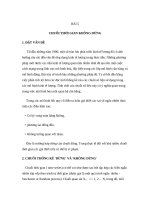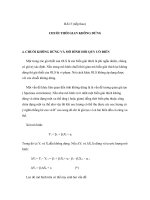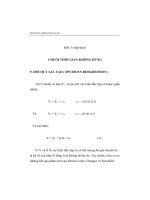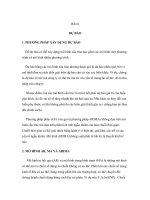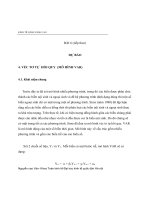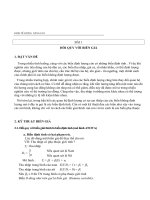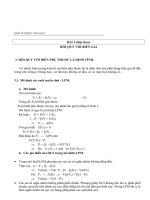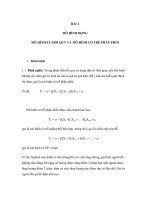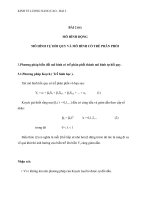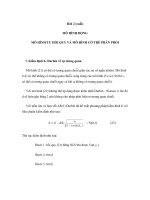KINH TẾ LƯỢNG NÂNG CAO (TRÌNH ĐỘ TIẾN SĨ)
Bạn đang xem bản rút gọn của tài liệu. Xem và tải ngay bản đầy đủ của tài liệu tại đây (141.3 KB, 11 trang )
Nội dung chương trình
“Kinh Tế Lượng Nâng Cao”
Kinh tế lượng (Econometrics) là công cụ chủ yếu của các nhà nghiên cứu trong các chuyên
ngành kinh tế và tài chính (Economics and Finance). Khi tiến hành các nghiên cứu hàn lâm
(academic research) với số liệu kinh tế và tài chính, việc xây dựng, ước lượng và kiểm định
các mơ hình sử dụng các cơng cụ kinh tế lượng là hướng nghiên cứu chủ yếu (mainstream
research) được thừa nhận rộng rãi trên thế giới.
Khóa học kinh tế lượng nâng cao nhằm trang bị cho học viên những kiến thức ở cấp độ cao
nhất trong kinh tế lượng về mặt lý thuyết cũng như thực hành. Các mơ hình kinh tế lượng sẽ
được giới thiệu chi tiết nền tảng lý thuyết, các tính chất của các ước lượng sẽ được khảo sát
về mặt lý thuyết và minh họa bằng các chương trình mơ phỏng (simulation) viết trên
MATLAB. Các bài thực hành với số liệu sẽ sử dụng STATA hoặc EVIEWS. Các phương
pháp và phát triển mới nhất trong kinh tế lượng cũng sẽ được đề cập và thảo luận.
Để tham gia tốt khóa học, học viên được yêu cầu có kiến thức vững chắc về xác suất thống kê
và đại số tuyến tính ở trình độ đại học, đặc biệt là các phép tính tốn trên ma trận. Học viên
cũng được cho là đã học qua các môn kinh tế lượng ở trình độ nhập mơn hoặc trung cấp
(introductory or intermediate level). Tài liệu ôn tập kiến thức xác suất thống kê và đại số ma
trận sẽ được phát cho học viên vào đầu khóa học.
Bài giảng (lecture notes) của khóa học sẽ được cung cấp cho học viên. Khóa học sử dụng
tiếng Việt, nhưng các tài liệu cung cấp cho học viên sẽ bằng tiếng Anh.
Tài liệu tham khảo chính:
William H. Greene, “Econometric Analysis”, 7th edition, 2012
(Ghi chú: việc mua tài liệu tham khảo là khơng bắt buộc vì bài giảng được soạn chi tiết)
Khóa học sẽ bao gồm 3 học phần:
1. Kinh tế lượng: các vấn đề căn bản
2. Lựa chọn rời rạc và kinh tế lượng vi mô (micro-econometrics)
3. Chuỗi thời gian và kinh tế lượng vĩ mô (macro-econometrics)
Học phần 1 là yêu cầu tiên quyết (pre-requisite) cho học phần 2 hoặc học phần 3. Điều này có
nghĩa là, sau phần 1, tùy theo dự định nghiên cứu của cá nhân, học viên có thể lựa chọn phần
2 hoặc phần 3 (hoặc cả hai) để học tiếp.
Để tham gia các học phần, học viên được trơng đợi là trang bị máy tính với các phần mềm
EVIEWS hoặc STATA. Việc có khả năng viết các chương trình mơ phỏng trên MATLAB
được khuyến khích, tuy rằng điều này là không bắt buộc.
1
Đánh giá cuối mỗi học phần:
Khóa học mở rộng và tự nguyện cho các đối tượng trong thông báo. Các bài tập lý thuyết và
ứng dụng sẽ được giao cho học viên, học viên sẽ làm các bài tập đó trên tinh thần tự giác.
Cuối mỗi học phần, học viên được yêu cầu chọn một đề tài ứng dụng với số liệu thực tiễn, và
tiến hành viết một bài nghiên cứu ứng dụng. Tối đa 2 học viên có thể kết hợp để viết một bài
nghiên cứu. Các đề tài và cách khai thác các nguồn số liệu trên internet sẽ được thảo luận trên
lớp. Hạn nộp bài là 8 tuần sau khi kết thúc học phần.
Học viên chỉ được coi là hồn thành học phần sau khi đã trình bày bài nghiên cứu ứng dụng
của mình cho giảng viên của khóa học.
2
University of Economics - Ho Chi Minh City
2012
ADVANCED ECONOMETRIC COURSE (PhD level)
PART I
BASIC ECONOMETRIC MODELS
Chapter 1: LINEAR REGRESSION MODEL
I. Model
II. Assumptions of the Classical Regression Model
III. Ordinary Least Squares Estimation (OLS)
IV. Algebraic Properties of Least Squares
V. Partitioned Regression
VI. Goodness of Fit
Chapter 2: FINITE SAMPLE PROPERTIES OF LEAST SQUARES
ESTIMATORS
I. Unbiased
II. Linearity
III. VarCov( βˆ ), estimation of σˆ 2
IV. Efficient
V. Gauss - Markov Theorem
VI. Review of Stochastic Inference
1. Normally distributed vector
2. Chi-squares distribution
3. Eigenvalue - Eigenvector problem
4. F and t-distribution
VII. Testing Hypothesis on Individual Coefficients
3
VIII. Family of F-test
Chapter 3: STOCHASTIC REGRESSION MODEL
I. Asymptotic Properties of the Least Squares Estimators
1. Consistency
2. Cramer theorem
3. Slutsky Theorem
II. Stochastic Regression
1. Stationary random variable
2. Unbiasedness of βˆ
3. VarCov ( βˆ )
4. Consistency of βˆ
III. Limiting Distributions and Asymptotic Distributions
1. Definition
2. Central limit theorem
3. Proposition
IV. Asymptotic Distribution of βˆ
Chapter 4: INSTRUMENTAL VARIABLES ESTIMATION
I. Endogeneity Problem
1. Errors in measurement of independent variables
2. Jointly determined variables
3. Omitted variables
4. Lagged dependent variables
II. Estimation by Instrumental Variable
III. Two-stage Least Squares Estimation
IV. Asymptotic Distribution of βˆ IV
V. Hausman’s Specification Test and an Application to IV estimation
1. Theorem
2. Hausman’s test
4
3. Wu’s approach
VI. Choosing Instruments
Chapter 5: INFERENCE AND PREDICTION
I. Nested and Non-nested Models
II. Wald test
1. The asymptotic χ2 distribution and exact F-distribution
2. The restricted least squares estimatiors
Chapter 6: DUMMY VARIABLES
I. Intercept Dummy
II. Intercept Dummy with Interactions
III. Seasonal Effects
IV. Differences in Differences
V. Test for Structural Break
Chapter 7: GENERALIZED LINEAR REGRESSION
I. Model
II. Properties of OLS Estimators
III. White’s Heteroskedasticity Consistent Estimator for VarCov( βˆ )
IV. Generalized Least Squares Estimation
V. Feasible GLS Estimation
Chapter 8: HETEROSKEDASTICTY
I. Properties of OLS Estimator under Heteroskedasticity
II. Testing for Heteroskedasticity
III. Treatment for Heteroskedasticity
5
Chapter 9: AUTOCORRELATION
I. Properties of OLS Estimator under Autocorrelation
II. Disturbance Processes
III. Treatment for Autocorrelation
IV. Testing for Autocorrelation
V. Neway-West Procedure for Consistent Estimation of VarCov( βˆ )
Chapter 10: MODELS FOR PANEL DATA
I. General Framework
II. Panel Regression
III. Fixed-Effects Models
1. Least Squares Dummy Variables (LSDV) model
2. Within-estimator and Between-estimator
3. Fixed time and Group effects
4. Unbalanced panel
5. Testing for group effect
6. Shortcoming of fixed-effect model
7. Autocorrelation and Heteroskedasticity in fixed-effect model
IV. Random Effects Model
V. Choosing between Fixed-Effects and Random Effects Model
VI. Finding the big VarCov( βˆ )
Chapter 11: SEEMINGLY UNRELATED REGRESSION (SUR)
I. Model
II. Kronecker Product
III. Generalized Least Squares (GLS)Estimation for SUR
IV. Feasible GLS Estimation for SUR model
V. Cases in which there is no efficiency gain of SUR over OLS
VI. Hypothesis Testing and Autocorrelation in SUR
6
Chapter 12: SIMULTANEOUS EQUATION MODELS
I. Model
1. General framework
2. Reduced form
II. Rank and Order Conditions for Identification
III. Estimation of a Simultaneous Equation Model
1. OLS estimation
2. Two-stage least squares (2-SLS)method
3. Computational formula for 2-SLS
4. Three-stage least squares estimation
Chapter 13: GENERALIZED METHOD OF MOMENTS (GMM)
ESTIMATION
I. The Basic for The GMM estimation.
1. Estimation based on orthogonality condition
2. Generalizing the method of moments
3. Properties of the GMM estimator
II. GMM and Conventional Estimators
1. GMM and IV, 2-SLS
2. Why use GMM?
III. GMM Estimation of Econometric Models
1. Single-equation linear models
2. Seemingly unrelated regression models
3. Simultaneous equations models with heteroskedasticity
7
PART II
DISCRETE CHOICE AND MICRO-ECONOMETRICS
Chapter 1: DISCRETE CHOICE ANALYSIS: BINARY OUTCOMES
I. Models for Binary Outcomes
II. Estimation and Inference in Binary Choice Models
1. Marginal effects and average partial effects
2. Measuring goodness of fit
3. Hypothesis Tests
4. Specification Analysis
III. Binary Choice Models for Panel Data
IV. Multivariate Probit Model
Chapter 2: DISCRETE CHOICE ANALYSIS: MULTINOMIAL AND
EVEN COUNTS MODELS
I. Models for Unordered Multiple Choices
1. The multinomial logit model
2. The conditional logit model
3. The independent from irrelevant alternatives (IIA) assumption
4. Nested logit models
5. The mixed logit model
II. Random Utility Models for Ordered Choices
III. Models for Counts of Events
1. The Poisson regression model
2. Measuring goodness of fit
3. Testing for overdispersion
4. Negative binomial regression model
5. Two-part models: zero inflation and hurdle models
8
Chapter 3: LIMITED DEPENDENT VARIABLES
I. Truncation
1. Truncated distribution
2. The truncated regression model
3. The stochastic frontier model
II. Censored Data
1. The censored normal distribution
2. The Tobit model
3. Heteroskedasticity and non-normality
III. Sample Selection Models
1. Incidental truncation in a bivariate distribution
2. Regression in a model of selection
3. Two-step and maximum likelihood estimation
4. Panel data applications of sample selection models
IV. Evaluating Treatments Effects
1. Regression analysis of treatment effects
2. Propensity score matching
3. Regression discontinuity
9
PART III
TIME SERIES AND MACRO-ECONOMETRICS
Chapter 1: STATIONARY TIME-SERIES MODEL
I. Stochastic Difference Equation Model
II. ARMA Model
III. Stationary
IV. Properties of Forecasts
Chapter 2: MODELING VOLATILITY
I. ARCH Processes
II. A GARCH Model of Risk
III. The ARCH-M Model
IV. Properties of GARCH Processes
V. Maximum-Likelihood Estimation of GARCH Model
VI. Multivariate GARCH
Chapter 4: VECTOR AUTOREGRESSION MODEL (VAR)
I. Introduction to VAR analysis
II. Estimation and Identification
III. The Impulse Response Function (IRF)
IV. Testing Hypotheses
V. Structural VARs
Chapter 5: NON-STATIONARY DATA
I. Non-stationary Processes and Unit Roots
1. Integrated processes and differencing
2. Random walks and trend
10
3. Spurious regressions
4. Testing for unit roots
II. Cointegration
1. Common trends between non-stationary variables
2. Testing for cointegration
3. Estimating cointegrating vector
III. Vector Error-Correction Model
1. The Engle-Granger methodology
2. Trace and maximum eigenvalue tests for cointegration
3. The Johansen methodology
IV. Non-stationary Panel Data
1. Testing for unit roots and cointegration in non-stationary panel
2. Models estimation using non-stationary panel data
11
